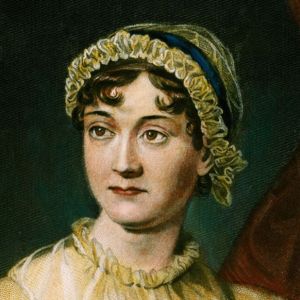
There were plenty of women writers by the end of the century, but their novels were chiefly concerned with highly coloured romance in aristocratic circles, often disguised as history, or with mystery-horror stories involving pathetic love affairs. Of humour they had none.
If one wishes to find an example of humorous writing by a woman born before the present century, one must always refer to Jane Austen. Yet, although her works were published in the 1800's, her style belongs to an earlier period, and, indeed, much of the preliminary writing of her novels was done before the turn of the century.
Because she was born in the countryside and spent all her life in the provinces, she dealt with the secluded parts of England; and as she was accustomed only to the commonplace events of upper middle-class society, she confined her characters to the genteel men and women whose main purpose in life was to live comfortably on incomes derived from well-managed estates. She was a snob, a gentle snob: for her, poverty was an unfortunate state of affairs that was either ignored or rectified by kind friends; vice did not exist, and mankind's worst failing was vulgarity; no moral lesson was implied in any of her books because she saw no reason to stress principles that she took for granted.
Because she never married yet was by nature a most affectionate woman, her short life was devoted to the concerns of her family. To her, Bath and Southampton were centres of polite society; her days were spent in rectories, well-appointed apartments, or manor houses; her pleasures were those derived from social gatherings in the home or in the houses of friends, or from carrying on a leisurely correspondence.
As a writer Jane Austen had an inauspicious beginning. She started a novel on a most unfavourable subject, and left it unfinished; she tried again, put the manuscript aside, and left it unpublished for about fifteen years; she wrote yet another novel and, having actually sent it to a publisher, accepted his rejection and locked the story away for the same length of time.
It was after these unsuccessful attempts at writing that Jane Austen was inspired, as Fielding had been, to write a parody of a popular novel. Earlier, she had completed a short and highly amusing skit on gushing romance and melodramatic passion, but Love and Freindship remained in manuscript until 1922.
Mrs. Radcliffe's Mysteries of Udolpho began a craze for ancient castles, secret passages, ghosts and unnamed terrors, foreign places wrapped in gloom, orgies of revenge, family secrets too dreadful to recount, hapless heroines and conscience-laden barons. Northanger Abbey was to parody this form of literature. It was written in 1798 and sold to a publisher five years later. The publisher, however, regretted the transaction for he made no effort to print what he had bought; yet when he had kept the manuscript for six years and Jane Austen tried to recover it, he refused to surrender it. Some eighteen years after writing the book, the author managed to regain possession of her story, but she died without ever seeing it in the bookshops.
Northanger Abbey is typical of her novels in that it presents a rich squire whose chief concern is money and prestige, and his family who are intelligent, humorous people with no need to earn a living. As a contrast, the heroine belongs to a gentleman's family but depends on the patronage of her rich acquaintances. The book deals with courtship but there is nothing about love; hero and heroine pursue their amiable way, gossip, entertain, and eventually marry. But Catherine Morland is shown as a silly thing, a typical romance-stricken teenager whose imagination has been stimulated by too close a study of Udolpho and the like; she expects mystery and murder as soon as 'Abbey' is mentioned. Her admirer, on the other hand, is a sane and balanced man who, from his superior situation, can view with amusement the foolishness of the girl, and try, gently and politely, to rid her of the nonsense that makes her ridiculous.
This novel is more than an attempt to poke fun at silly tales; it also reveals the gay life of Bath, it exhibits forms of vulgarity and gross snobbishness; it describes the slow progress of refined affections. Because all are contained in a fairly short book, the reader is never sure of its main purpose. Nevertheless, no matter how one views the construction of the episode at the Abbey, one can smile with Henry Tilney at the bewilderment and embarrassment of Catherine when reality contradicts fantasy, and airy imaginings are confronted with the hard facts of actual life.